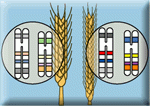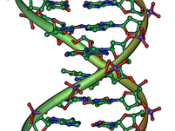SEQUENOM Analysis
ABOUT SEQUENOM
SEQUENOM, Inc., a genetics company, provides genetic analysis products that translate genomic science into superior solutions for biomedical research and molecular medicine.
The Company has created high-performance DNA analysis technology that efficiently and precisely measures genetic variation.
Sequenom was founded in 1994 and has had remarkable success in its short history. Since its start-up in 1994, Sequenom has established international operations, launched major products, achieved the second best IPO in the biotechnology industry, and built a strong base of top-notch customers. The Company's principal activity is to determine the medical impact of genes and genetic variations known as single nucleotide polymorphisms.
SEQUENOM dedicated to the sales and support of the company's MassARRAY platform, and to the continued expansion of DNA analysis applications for use with this system. It has created high-performance DNA analysis technology that efficiently and precisely measures genetic variation. Their proprietary MassARRAY system is a high performance DNA analysis platform that efficiently and precisely measures the amount of genetic target material and variations therein.
Sequenom has used MassARRAY technology and the company's extensive collections of DNA samples from diseased and healthy individuals to identify disease-related genes that affect the health of significant portions of the population. Through high-density genome-wide scans Sequenom has identified more than 60 candidate genes in breast, lung, prostate, and skin cancers; central nervous system disorders; metabolic and cardiovascular diseases; and musculoskeletal and inflammatory conditions. Based on its discoveries, Sequenom develops diagnostic content, and also outlicenses candidate target genes for diagnostic and therapeutic product development. Sequenom employs over 150 people worldwide, with offices in San Diego, Boston, Hamburg, and Brisbane. Since the launch of the MassARRAY system in 2000, Sequenom has sold over 100 systems and released a new benchtop version of the platform, the MassARRAY Compact.
BUSINESS MODEL
SNPs are common genetic markers that are useful for pharmacogenomics and other types of genetic studies. Sequenom has tried to take the best of the public SNP data and combine it with their proprietary information in such a way that provides the greatest use to researchers. Sequenom claims to have more confirmed SNPs than any other supplier.
Sequenom launched its RealSNP.com portal, which provides subscribers with a neat package of resources for SNP (Single Nucleotide Polymorphisms) research. Clients can confirm whether specific SNPs are known to be "real" (they occur commonly enough to be potentially useful genetic markers), look up SNP assays, and order Sequenom's confirmed assays from the site.
Subscribers to RealSNP.com will pay an upfront licensing fee between $20,000 to $100,000 (depending on their other contracts with the company), and then pay only for the parts of the database they use. RealSNP.com is a natural fit for the Web. Researchers don't have to send any of their valuable data out to the site to make use of it. Rather, they will go there to do searches and order assays.
Besides generating its own revenue, one goal of the site is to encourage more groups to buy Sequenom's MassARRAY genotyping platform, which is already one of the most popular with high-volume users. More than 65 of the systems have been sold to date.
The Company's proprietary MassARRAY system is a high-performance DNA analysis platform that efficiently and precisely measures the amount of genetic target material and variations therein. The system is able to deliver reliable and specific data from complex biological samples and from genetic target material that is only available in trace amounts.
On one side, Sequenom provided technology to other companies to do high-throughput genetic drug discovery. On another side, it tried to do its own. Based on the MassARRAY platform, Sequenom began doing the drug discovery and invest in the fields of gene expression, animal testing, and prenatal diagnostics.
Sequenom was organized into two distinct business segments: SEQUENOM Genetic Systems and SEQUENOM Pharmaceuticals.
SEQUENOM Genetic Systems is dedicated to the sales and support of MassARRAY products and the continued expansion of platform applications.
SEQUENOM Pharmaceuticals applies the power of human genetics to systematically identify disease-related genes that affect significant portions of the overall population. The pharmaceutical unit focuses on disease gene discovery, target identification, functional validation and ultimately diagnostic and therapeutic product development.
The Pharmaceuticals business unit uses MassARRAY technology and the Company's extensive collections of DNA samples from diseased and healthy individuals to conduct large-scale human genetics studies to systematically identify disease-related genes that affect the health of significant portions of the general population. The information from these studies is used for diagnostic and drug target identification followed by functional testing. The ultimate goals of the Pharmaceuticals business unit are diagnostic and therapeutic product development and commercialization.
SEQUENOM
SEQUENOM Genetic Systems SEQUENOM Pharmaceuticals
Service: RealSnap.com Product: Gene Drugs?? Genetic services Product: MassARRAY
Revenue
PROBLEMS
By 2003, the biotech industry leader had arrived at a crossroads, at which it needed to successfully transition to a more mature organization. With the promise of providing patients with medicines that are tailor-made to their genetic makeup, a slew of companies selling SNP technologies went public over the past few years. But after the initial burst of enthusiasm, funding for this promising technology has dried up and companies like Sequenom face a future of making every dollar count.
It is widely anticipated that some SNPs variations may have functional effects, a predisposition to disease, for instance, or a reduction in the efficacy of drugs in certain individuals. Once those associations are determined, identifying SNPs in patients will allow doctors to avoid prescribing drugs to individuals who are either unlikely to respond or who are predisposed to adverse reactions. The correlation between SNPs and diseases will also help drug companies in their search for new therapies.
By identifying these SNPs, the goal of drug companies is to be able to develop treatments that are based on our genes, but it could take years before that promise becomes a reality. It is estimated that the human genome contains 10 million SNPs and only a fraction of those are thought to influence individual traits. Wading through the enormous amount of data within the human genome to find the SNPs that cause diseases or drug reactions is both costly and time consuming. And that is where companies like Sequenom come in.
Sequenom Pharmaceuticals applies the power of human genetics to systematically identify disease-related genes that affect significant portions of the overall population. The pharmaceutical unit focuses on disease gene discovery, target identification, functional validation and ultimately diagnostic and therapeutic product development. Like we can find from the graph, when the company began to invest in Pharmaceuticals, the cost is keep increasing, and percentage is keeping get higher:
-----------------------------------------
But, to determine the medical relevance of a particular SNP, it is necessary to conduct SNP scoring in hundreds of thousands of patients, a process that can become very costly very quickly. Scoring 100 SNPs in 100,000 people costs $20 million using Sequenom's technology. Orchid's technology, which costs much less per SNP, one could cut that down to $1 million. Either way, the expense leads some analysts to question the commercial viability of SNPs.
And even those convinced that the study of SNPs will produce novel drug therapies admit that their usefulness is still a long way off. Right now, there are no drugs on the market due to gene hunting projects such as SNP detection and the situation is not likely to change any time soon.
"These SNP companies are dead in the water," said Charles Duncan, senior vice president of genomics research at Prudential Securities. "These companies are going to have a very hard time raising additional money going forward." That's right, after several years investing in the genomics research, Sequenom is facing big capital drought:
2001 2002 2003 2004 2005
Sequenom's management had made misjudgment. Rather than focusing on the core business of marketing its MassArray technology, they spent lots of money in developing its pharmaceutical business. We can find their spending is going higher with the time change, but at the same time, the revenues the Pharmaceuticals unit created is tiny compared to the cost:
-----------------------------------------
REEGINEERING
Since its' inception, Sequenom has incurred significant losses, had an accumulated deficit of $285.5 million. The leaders finally realized that in the current financial environment and with the resources available, they couldn't afford to both conduct internal drug discovery efforts as well as invest in attractive business opportunities in the Genetic Systems business unit. So they decided to put focus on building the Genetic Systems unit where they are currently generating revenue.
-----------------------------------------
On the end of July 2004, SEQUENOM announced the termination of internal drug discovery efforts along with the closure of the Company's Pharmaceuticals business unit. Going forward, the Company will concentrate on revenue-generating opportunities from its Genetic Systems business unit in the genetic research and diagnostic services markets. SEQUENOM will continue its out licensing program to capitalize on the value of its genetic targets for diagnostic and therapeutic product development.
The closing of the Pharmaceuticals business unit will reduce the Company's costs and expenses and is expected to provide the cash necessary to support the Company's Genetic Systems business through 2006. By year-end, there will be a staff reduction of approximately 50 employees. The majority of costs related to this restructuring will be recorded in the third quarter of 2004. The resulting anticipated annualized cash flow savings is approximately $10 million.
"Sales of the MassARRAY(TM) Compact, our flexible bench top system, are gaining traction," said Steve Zaniboni, SEQUENOM's Chief Financial Officer. "Four of the seven system sales this quarter were Compacts. We have expanded the capabilities of the MassARRAY platform from high-throughput genotyping to include the mid-range throughput segment for virtually all relevant applications in RNA and DNA analysis, enabling SEQUENOM to service the broad needs of the clinical research and diagnostic services market. We expect to redefine standards of data quality in these new application areas."
ASSESSMENT
New Business Strategy
Sequenom should have a more focused strategic vision, put their focuses on the process of stabilizing the core genetic analysis business and prioritizing key product and service initiatives that, in due course, are expected to drive growth and create value.
Their core technology is demonstrating emerging utility in the molecular diagnostics market. We plan to pursue partnering opportunities for the development and commercialization and the adaptation of the MassARRAY system for molecular diagnostics.
Their corporate restructuring and revised business strategy focuses on leveraging our assets primarily in the fine mapping segment of the research market, and capitalizing on our potential in the molecular diagnostics market.
Sequenom's strategy should include the following two aspects:
Products - MassARRAY Series
Sequenom's MassARRAY system is a genetics analysis platform that provides reliable results across a wide range of applications. While the MassARRAY system is versatile, it also possesses single molecule and single cell sensitivity that can, in combination with the specificity of mass spectrometry, be used to recognize and quantify genetic variations that are impossible or difficult to detect with other technologies.
The MassARRAY system has been used for SNP analysis since its launch in 2000. Since that time, Sequenom has leveraged their MassARRAY technology's data quality and reliability into the following capabilities and applications: MassARRAY SNP genotyping, MassARRAY QGE, MassARRAY SNP Discovery and etc.
The MassARRAY Series are very succeed and also the only profitable part in Sequenom. Sequenom should keep working on those products:
⢠Expanding the use of our MassARRAY platform to drive new sales through applications such as QGE, methylation and single mutation discovery;
⢠Offering products and services that capture more value and provide more powerful and quality solutions to our customers, including QGE and methylation services;
⢠Creating a sustainable competitive advantage by launching a series of applications that significantly reduces cost per genotype, beginning with the iPLEX multiplexing assay;
⢠Introducing a cost effective MassARRAY solution for lower throughput users; and
Research - Clinical Diagnostics
The MassARRAY system is used in numerous academic, pharmaceutical and clinical research institutions in the biomedical research market. These customers conduct genome-wide and candidate gene scans in their efforts to identify genetic markers with clinical utility.
Institutions in this market are typically concerned with whole genome population genetics studies, whole genome association studies and linkage studies. Whole genome population studies are conducted for general research purposes to create single nucleotide polymorphism ("SNP") maps and to determine allelic frequencies in different ethnicities and species. Whole genome association studies and linkage studies are conducted for genetic discovery purposes. In general, these studies are high throughput studies that analyze a small number of samples against a high number of SNPs.
Once target regions are identified and connections to disease are made, institutions then typically perform fine mapping studies, which are conducted in an effort to apply genetics to diseases. Customers conduct candidate region associations to narrow down regions of interest where previous linkage studies have correlated disease phenotypes to specific regions on the chromosome. Candidate gene association studies demonstrate for specific patient samples that underlying genetic defects reside in specific biological pathways. From there, biomarker discovery efforts can potentially lead to clinical validation and use.
Institutions conducting fine mapping studies use the MassARRAY system to perform candidate gene and candidate region association studies. These studies, which typically analyze up to 2,000 SNPs with tens of thousands of samples, can be performed on our MassARRAY system, which is well suited for the middle and lower throughput genetic analysis markets.
⢠Focusing on meeting customer needs in the fast growing fine mapping segment of the genetic analysis market and adding additional pharmaceutical, biotechnology, veterinary and molecular diagnostic companies to our research customer base;
⢠Developing multiplexed quantitative methylation and multiplexed QGE for fine mapping and molecular diagnostics;
⢠Leveraging our proprietary biomarker content into partnerships and proprietary tests.
References
www.wallstreetjournal.com
www.sequenom.com
finance.yahoo.com


